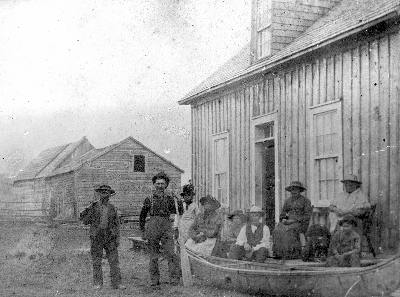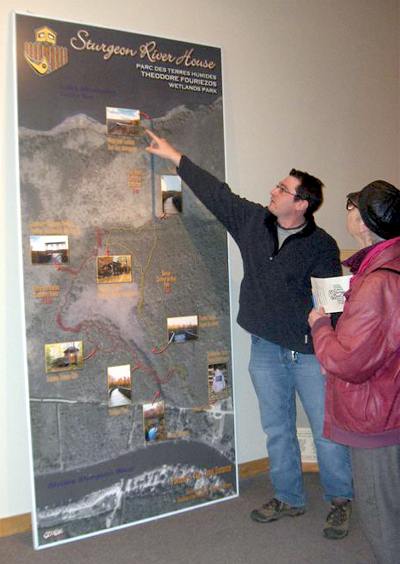 |
April 21, 2006Voyageurs Visit the Sturgeon River
House Museum
|
A large group of voyageurs
will be descending on the Sturgeon River House Museum tomorrow. They are not
coming by canoe but by car. They are representatives from various museums and
related organizations from the area roughly enclosed by Mattawa, Parry Sound,
Blind River, and Haileybury. This organization called the Voyageur Heritage
Network (VHN) was formed in 1983 “to help heritage and cultural groups develop
and offer better services to their communities”.
 |
Photos
of Sturgeon River House from late 1870s – Norman McLeod – last manager
before the post moved to Sturgeon Falls in 1880. Museum photo |
The VHN meets a couple of
times a year in different museums and communicates regularly during the year.
The Saturday meeting is a business meeting with interesting and relevant
programs in the afternoon in a session open to the public. I will be involved,
as will voyageur interpreter Mike Buss dressed in full costume and talking about
the voyageur way of life.
The museum is open 5 days a
week and will be open this Saturday for this meeting. You can find the museum
by turning left on Leblanc Road just west of Sturgeon Falls and following the
signs.
The Museum
The Sturgeon River House
Museum started small as a centennial project by the Municipality of Sturgeon
Falls in 1967 and has expanded remarkably over the years. It has a rebuilt fur
trade pioneer village on the site of the former fur trading post on the river
there from 1850 to 1880.
The inner court features a
blacksmith shop, pioneer log home, ice house, etc. A large 12,000 square foot
main building features a wide variety of fur trade artifacts plus extensive
local history material on two floors. The Francophone archives from the
Francophone historical society that I wrote about in May 2004 has relocated its
archives from North Bay to an archive room on the second floor of the museum. A
gift shop and snack bar are available.
The museum has also
developed an extensive Theodore Fouriezos Wetland Park that provides a
fascinating nature walk. One of the expanding winter programs at the museum is
centred around snow shoe walks that large groups of children enjoy. A brochure
outlines many other activities including guided tours, a Cranberry Festival with
cranberry picking and cranberry treats (October 14-15) and a Traditional Family
Christmas (December 10, 2006). Phone 753-4716 for information or go online at
info@sturgeonriverhouse.com.
 |
Curator Serge Ducharme
describing Trail layout at the Museum. D. Mackey photo. |
I visited the Museum
recently and had a tour with Museum Curator Serge Ducharme. Of special interest
was their icehouse and ice harvest because I wrote about the topic last week.
They have an icehouse with lots of sawdust and they cut and store ice as a
museum project. The ice was not suitable this year but a photo story of the
2005 event can be seen on their website. Serge described the museum operation
including the trail system and showed me their storage and workspace. An intern
has been acquired to begin to upgrade and reorganize some of the displays.
He also provided me with
some of the history of the original Post as provided by the Hudson’s Bay
Archives. The photo shows the original post with post manager Norman McLeod
(1869-1880) on the left. He died there and the post coincidentally was closed
about the same time.
The original post in the
Sturgeon Falls area was in a couple of other locations before settling on the
west bank of the Sturgeon River. A plan shows the site with a native burial
ground opposite on the other side of the river indicating a native camp there
doing business with the post. The original trading post on Lake Nipissing was
on the LaVase River outlet into Lake Nipissing in North Bay. Toussaint de la
Ronde was the first manager from 1821 to 1824 – 182 years ago. The original
company was the North West Company which joined with the Hudson’s Bay Company
and became the Hudson’s Bay Company in 1821.
The Lake Nipissing post was
a sub post of the larger post at Lake Temiskaming as was the post at Mattawa and
Temagami. There was heavy “opposition” from “free traders” who used whiskey to
buy furs for profit and resale. The post harvested cranberries for distribution
to other areas for years as one of its activities. The Hudson’s Bay Company
sold the 288 acre site to local settlers prior to its acquisition by the town.
The Museum is owned and
operated by West Nipissing and the Board is a municipal board. Councillor David
Lafleur is on the Board and serves as the chair of the Voyageur Heritage Network
and will oversee the event tomorrow in the Museum’s fine meeting room.
Congratulations to the Museum and the Network for their good work.
Heritage Perspective Home Page
| 
![]() Past
Forward is now on Facebook "LIKE" us to keep in touch
Past
Forward is now on Facebook "LIKE" us to keep in touch